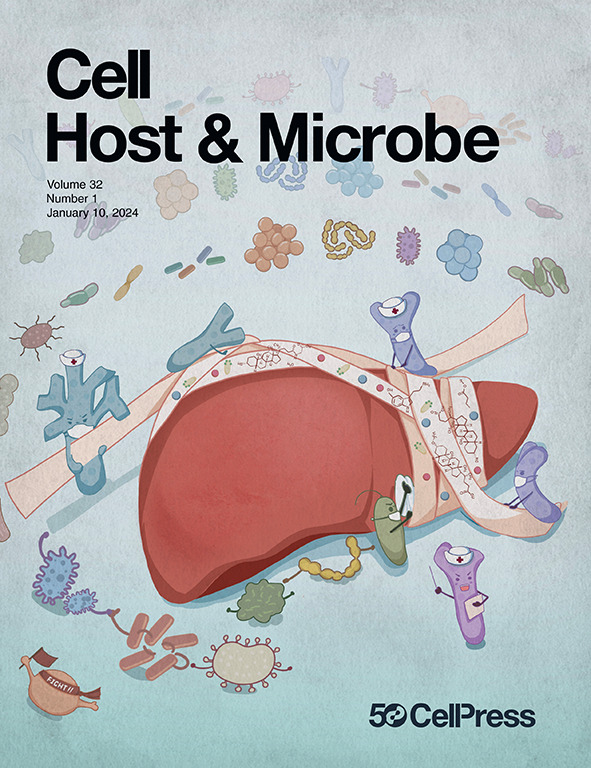Bacteroides fragilis promotes chemoresistance in colorectal cancer, and its elimination by phage VA7 restores chemosensitivity
IF 18.7
1区 医学
Q1 MICROBIOLOGY
引用次数: 0
Abstract
Chemoresistance is a main cause of colorectal cancer (CRC) treatment failure. We identified that Bacteroides fragilis is enriched in patients with CRC resistant to chemotherapy in two independent cohorts, and its abundance is associated with poor survival. Consistently, administration of B. fragilis to CRC xenografts and ApcMin/+- and AOM/DSS-induced CRC mice all significantly attenuated the antitumor efficacy of 5-FU and OXA. Mechanistically, B. fragilis colonized colon tumors and mediated its effect via its surface protein SusD/RagB binding to the Notch1 receptor in CRC cells, leading to activation of the Notch1 signaling pathway and the induction of epithelial-to-mesenchymal transition (EMT)/stemness to suppress chemotherapy-induced apoptosis. Either deletion of SusD/RagB or blockade of Notch1 signaling abrogated B. fragilis-mediated chemoresistance. Finally, B. fragilis-targeting phage VA7 selectively suppressed B. fragilis and restored chemosensitivity in preclinical CRC mouse models. Our findings have offered insights into the potential of precise gut microbiota manipulation for the clinical management of CRC.

脆弱拟杆菌促进结直肠癌的化疗耐药,通过噬菌体VA7消除其可恢复化疗敏感性
化疗耐药是导致结直肠癌治疗失败的主要原因。在两个独立的队列中,我们发现脆弱拟杆菌在结直肠癌化疗耐药患者中富集,其丰度与较差的生存率相关。同样,给结直肠癌异种移植物和ApcMin/+-和AOM/ dss诱导的结直肠癌小鼠施用脆性芽孢杆菌均显著降低了5-FU和OXA的抗肿瘤作用。在机制上,脆弱芽胞杆菌定植结肠肿瘤,并通过其表面蛋白SusD/RagB结合结直肠癌细胞的Notch1受体介导其作用,激活Notch1信号通路,诱导上皮-间质转化(EMT)/干性,抑制化疗诱导的细胞凋亡。缺失SusD/RagB或阻断Notch1信号通路均可消除易碎芽胞杆菌介导的化学耐药。最后,在临床前CRC小鼠模型中,靶向脆弱芽孢杆菌的噬菌体VA7选择性地抑制脆弱芽孢杆菌并恢复化学敏感性。我们的研究结果为CRC临床管理中精确肠道微生物群控制的潜力提供了见解。
本文章由计算机程序翻译,如有差异,请以英文原文为准。
求助全文
约1分钟内获得全文
求助全文
来源期刊

Cell host & microbe
生物-微生物学
CiteScore
45.10
自引率
1.70%
发文量
201
审稿时长
4-8 weeks
期刊介绍:
Cell Host & Microbe is a scientific journal that was launched in March 2007. The journal aims to provide a platform for scientists to exchange ideas and concepts related to the study of microbes and their interaction with host organisms at a molecular, cellular, and immune level. It publishes novel findings on a wide range of microorganisms including bacteria, fungi, parasites, and viruses. The journal focuses on the interface between the microbe and its host, whether the host is a vertebrate, invertebrate, or plant, and whether the microbe is pathogenic, non-pathogenic, or commensal. The integrated study of microbes and their interactions with each other, their host, and the cellular environment they inhabit is a unifying theme of the journal. The published work in Cell Host & Microbe is expected to be of exceptional significance within its field and also of interest to researchers in other areas. In addition to primary research articles, the journal features expert analysis, commentary, and reviews on current topics of interest in the field.
 求助内容:
求助内容: 应助结果提醒方式:
应助结果提醒方式:


